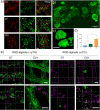Microfluidic 3D Bioprinting of Foamed Fibers with Controlled Micromorphology
- PMID: 39964244
- PMCID: PMC11891826
- DOI: 10.1021/acsami.4c22450
Microfluidic 3D Bioprinting of Foamed Fibers with Controlled Micromorphology
Abstract
The synergistic integration of microfluidic technologies with additive manufacturing systems is advancing the development of innovative platforms to 3D bioprint scaffolds for tissue engineering with unparalleled biological relevance. Significant interest is growing in realizing porous functionally graded materials (pFGMs) that can resemble the hierarchical organization of porosity found in bone tissue. This study introduces a method for fabricating porous scaffolds based on the real-time generation of a liquid foam, which is gelled, forming porous fibers that are organized into structured matrixes using a 3D bioprinting system. The primary advantage of this approach is the possibility to adjust bubble size during printing dynamically, modifying the characteristics of the deposited foamed filaments online and in one step. As a result, locally-defined and tailor-made pores can be distributed in 3D structures with high spatial accuracy. Besides the mechanical and morphological characterization of diverse microarchitectures, we also explored the biocompatibility of the proposed approach by directly embedding osteosarcoma cells within the biomaterial. Results demonstrated the biocompatibility of the proposed methodology and revealed the influence of the interior microporosity on cell proliferation, highlighting the potential for creating tailored tissue microenvironments. The findings underscore the versatility of the presented 3D bioprinting system and its potential in fabricating biomimetic scaffolds with tailored morphological gradients, representing a substantial advancement in pFGM synthesis, with direct implications in regenerative medicine and tissue engineering.
Keywords: 3D bioprinting; foam; gradient; microfluidic; porous functionally graded materials; printhead.
Conflict of interest statement
The authors declare no competing financial interest.
Figures





References
MeSH terms
Substances
LinkOut - more resources
Full Text Sources
Research Materials

